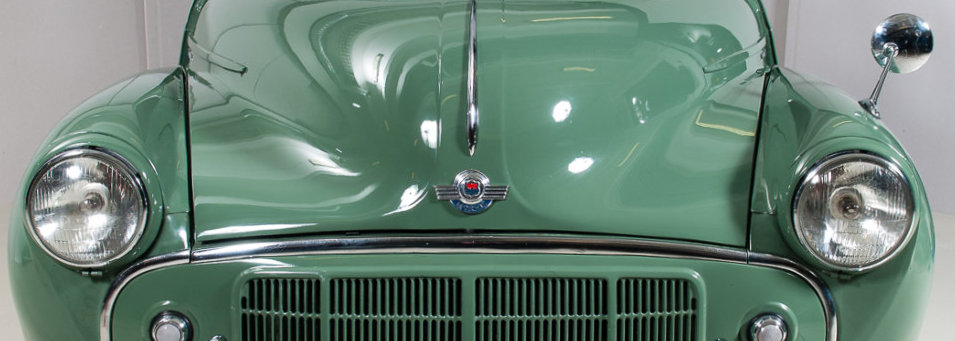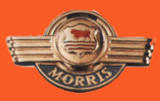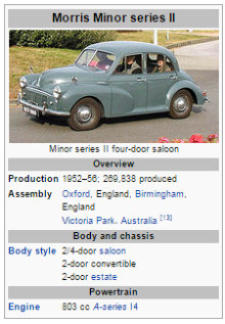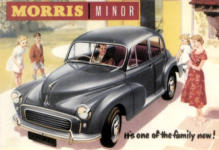



Minor Series II started 1952

Morris Minor - 52
The Morris Minor is a British economy car that debuted at
the Earls Court Motor Show, London, on 20 September
1948.
Designed under the leadership of Alec Issigonis, more than 1.3 million were manufactured between 1948 and 1972. Initially available as a two-door saloon and tourer (convertible), the range was subsequently expanded to include a four-door saloon in 1950, a wood-framed estate (the Traveller) from 1952 and panel van and pick-up truck variants from 1953. The Minor was manufactured in three series: the MM (1948), the Series II (1952) and finally the 1000 series (1956).History
Alec Issigonis' concept was to combine the luxury and convenience of a good motor car at a price affordable by the working classes. The Minor was a roomy vehicle with superior cornering and handling characteristics. Internal politics inside BMC, the owner of Morris, may have led to the limited North American sales. The Minor prototype had been known as the Morris Mosquito. More than 1.3 million of the lightweight, rear-wheel drive cars were eventually produced, mainly in Cowley, Oxfordshire, becoming Britain's first million seller, and exported around the world, with many variants of the original model. Production continued in Birmingham, England until 1972 (for the commercial variants and estate only). The last Morris Minor (commercial) was assembled at Stoke, Nelson, New Zealand in 1974. The Minor has been described as typifying "Englishness", a "British icon" and a "design classic".Minor Series II
In 1952, the Minor line was updated with an Austin-designed 803 cc (49.0 cu in) overhead valve A-series engine, replacing the original side-valve unit. The engine had been designed for the Minor's main competition, the Austin A30, but became available as Austin and Morris were merged into the British Motor Corporation. The new engine felt stronger, though all measurements were smaller than the old. The 52 second drive to 60 mph (97 km/h) was still calm, with 63 mph (101 km/h) as the top speed. Fuel consumption also rose to 36 miles per imperial gallon (7.8 L/100 km; 30 mpg-US). An estate version was introduced in 1952, known as the Traveller (a Morris naming tradition for estates, also seen on the Mini). The Traveller featured an external structural ash (wood) frame for the rear bodywork, with two side-hinged rear doors. The frame was varnished rather than painted and a highly visible feature of the body style. Commercial models, marketed as the Morris Quarter Ton Van and Pick-up were added in May 1953. Rear bodies of the van versions were all steel. The 4-seat convertible and saloon variants continued as well. The Motor magazine tested a four-door saloon in 1952. It reported a top speed of 62 mph (100 km/h) and acceleration from 0–50 mph (80 km/h) in 28.6 seconds. A fuel consumption of 39.3 miles per imperial gallon (7.19 L/100 km; 32.7 mpg-US) was recorded. The test car cost £631 including taxes. Engine: 1952–56: 803 cc A-Series inline-four, 30 hp (22 kW) at 4,800 rpm and 40 lbf·ft (54 N·m) at 2,400 rpm
1952
Engine 803 cc 4 cylinders Power 30 hp


Photos mainly by Matti Kreivilä. Historical facts and technical details of the vehicles provided by Wikipedia. Movies YouTube.



- Decade of 60's
- Austin 850 Pickup - 1962
- Chaika Tshaika 13 GAZ - 1962
- Citroen 2CV - 1961
- DKW Junior - 1961
- Fiat 1100 - 1963
- Ford Taunus 12M - 1961
- GLAS 1204 - 1963
- MG 1100 - 1964
- Moskvich 407 - 1961
- Nagetusch caravan - 1961
- NSU Printz 4 - 1961
- Opel Kadett A - 1964
- Panhard PL17 - 1961
- Peugeot 404 - 1962
- Renault Dauphine - 1965
- Simca Aronde P60 - 1960
- Simca 1000 - 1966














